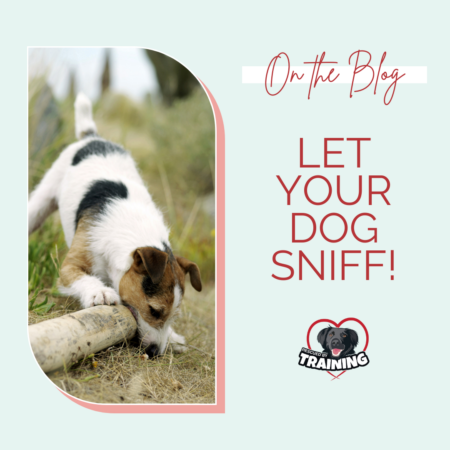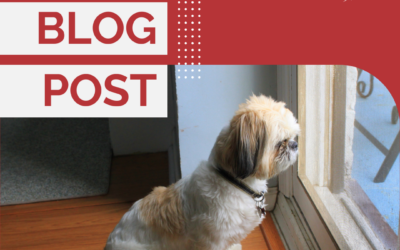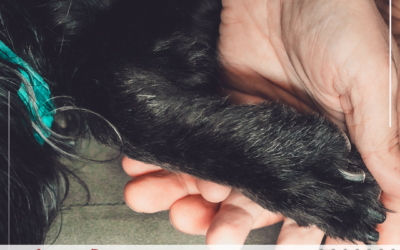Enrichment isn’t optional. It’s not a nice, extra thing we should be doing for our animals – it’s a critical part of their well-being, health and happiness. Having the ability to do normal dog behavior is one of the Five Freedoms, “freedom to express normal behavior by providing sufficient space, proper facilities and company of the animal’s own kind.” Enrichment is ensuring we are meeting all of a species needs. This is not optional. It is essential to your dog’s quality of life.
Perhaps the most important and easiest way to incorporate enrichment into your dog’s life is to let them sniff on walks. And I’m not talking about for 3 seconds while they’re trying to find a place to potty before you leash tug and say “ok, let’s go!” I’m talking about really letting them sniff. Letting them have a long line of 20 or 30 feet of distance to meander and decide where to walk, what route to take, what to sniff and for how long (all these assume a safe environment, of course.) Let them have a walk that is entirely up to them on where to sniff – a sniffari!
Even if you don’t cover the same physical distance, allowing your dog to sniff will tire them out. Sniffing is excellent brainwork, as your dog is processing all those smells in his world. Your dog’s walk should be about him enjoying it, not covering as much distance as possible.
We know dogs have amazing noses – that’s why we task them with sniffing out drugs, cancer, Covid and drops in blood sugar, among other things. We have around six million receptors and dogs have an astounding 300 million.
There is evidence from research by Dr. Alexandra Horowitz to support nosework, not heelwork, makes dogs more optimistic. “allowing dogs to spent more time using their olfaction through a regular nosework activity makes them more optimistic. By allowing dogs more “foraging” time, their welfare is improved.” (Abstract here though you can read Companion Animal Psychology’s analysis here.) Dr. Horowitz also has a whole book about this topic, “Being a Dog: Following the Dog into a World of Smell.” Read an interview with her here about this book or watch a Google Talk here.
Sniffing makes your dog feel good. The part of the brain that is activated by sniffing (the “seeking system”) is also the part of the brain that releases dopamine, a neurotransmitter important in regulating anxiety. Dopamine increases our attention, feelings of motivation and reward and is related to an enhanced memory. Every time you allow your dog sniff, you are allowing him the opportunity to feel good, reduce stress and self-soothe. (This is covered in detail in Affective Neuroscience: The Foundations of Human and Animal Emotions by Jaak Panskeep.)
“This system makes animals intensely interested in exploring their world and leads them to become excited when they are about to get what they desire. It eventually allows animals to find and eagerly anticipate the things they need for survival, including, of course, food, water, warmth, and their ultimate evolutionary survival need, sex. In other words, when fully aroused, it helps fill the mind with interest and motivates organisms to move their bodies effortlessly in search of the things they need, crave, and desire.”
I hear what you’re asking me. “But if I let my dog sniff, won’t he just drag me all over the place all the time?” No, because we can train a cue “go sniff” or something similar and we can train some loose leash walking exercises. They are not mutually exclusive.
But it is critical to remember that we can’t expect your dog to walk nicely on a loose leash if he’s been pent up and not given an opportunity to sniff. Your dog is not going to walk on a loose leash as soon as you head out on your walk, because he’s likely very excited to be going on a walk.
And while it might not be possible to take your dog on an extended long leash sniffari every day, you can absolutely incorporate ways to increase sniffing and scavenging enrichment in their daily lives.
Here are my top 10 ways to let your dog sniff!
- Go on a sniffari
- Get (or make) a snuffle mat
- Play Find It
- Play hide and seek with old toilet paper rolls filled with pieces of kibble or treats inside (ends folded in), which are hidden around your home or put them in a box to pull out.
- Use an old box and packing paper to roll treats or kibble in the paper and let your dog destuff the box
- Roll some treats in a towel or yoga mat and let them unroll it to uncover the treats
- Make a scavenger hunt or obstacle course
- Fill an old egg carton with kibble
- Play “which hand” where you present both hands closed but only one has a treat in it. You dog gets the treat when they paw or nose at the right hand
- Do a food scatter in your yard or on a plushy bath mat
As Dr. Horowitz says in her book, “Take a cue from the dog…I enjoy smells more now. They’re no longer good or bad. They tell me about the world. That’s as close as I get to being doglike.”
So, next time you’re out walking with your dog, try to take in the environment. Get off your phone and try to appreciate all that the world has to offer, and maybe you’ll understand a little better why your dog wants to sniff it all!
Happy training!
![]()




